|
|
|
Sort Order |
|
|
|
Items / Page
|
|
|
|
|
|
|
| Srl | Item |
| 1 |
ID:
180248
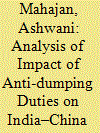

|
|
|
|
|
| Summary/Abstract |
India has imposed anti-dumping duties (ADDs) on a total of 155 commodities against China across many sectors to protect the domestic industry since 2001. The dumping of Chinese goods into Indian markets has led to the downfall and closure of many domestic industries. Under such circumstances, ADDs had been necessitated for protecting the domestic industry. As per the World Trade Organization (WTO) rules, imposition of ADDs on imports is permitted, provided that the affected country establishes that the domestic industry has suffered material injury by such imports. An elaborate discussion explaining the investigation pertaining to ADD and imposition of ADD in relation with WTO rules is presented in the present article. During the period between 2014 and 2018, ADD has been imposed on a total of 121 commodities. The study finds that ADDs have been partially effective in reducing the imports of the commodities.
|
|
|
|
|
|
|
|
|
|
|
|
|
|
|
|
| 2 |
ID:
068347
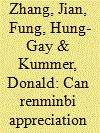

|
|
|
| 3 |
ID:
154539


|
|
|
|
|
| Summary/Abstract |
Myanmar's trade deficit has widened dramatically in the past few years. One of the reasons lies in the lack of trade finance for exporters and certain financial sector shortcomings more generally. This policy note introduces the idea of establishing a public Export Credit Guarantee Scheme (ECGS) and explores if and how this policy measure could support the rebalancing of Myanmar's trade deficit. Such a scheme could help relieve export constraints by: first, facilitating access to credit for exporters by mitigating risk and increasing banks' willingness to lend; second, helping exporters to offer better payment terms to importers; and third, contributing to enhance confidence in Myanmar entities (both banks and enterprises) among foreign entities. Looking at the experience of other countries, the policy note also points to a number of guiding principles that policymakers should consider when pondering the idea of setting up an ECGS. Moreover, it highlights that certain challenges have to be expected. First and foremost, given the low level of financial sector development and limited existing knowledge on trade finance, it is questionable whether the necessary skills and capacities to properly operate such a scheme are available in Myanmar. Seeking international support can help to address this issue. A practical way forward might be to pilot an ECGS with a rather small portfolio of products that targets one or a few sectors to test the ground while limiting the public resources at risk.
|
|
|
|
|
|
|
|
|
|
|
|
|
|
|
|
| 4 |
ID:
092879
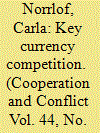

|
|
|
|
|
| Publication |
2009.
|
| Summary/Abstract |
In this article, I investigate whether the euro is set to eclipse the dollar as the world currency. Although the euro has gained in importance at the expense of the dollar in all key currency functions, I argue that it is not about to replace the dollar as the unique currency of global importance. Notwithstanding America's current weakness, I argue that different preferences for monetary and fiscal policy inside the euro-zone, and the need to coordinate these, will make it difficult to accommodate and correct large-scale imports over the long term. I also find that taking on the role of the world's preferred import destination is bound to exacerbate internal differences and complicate decision-making.
|
|
|
|
|
|
|
|
|
|
|
|
|
|
|
|
| 5 |
ID:
154726
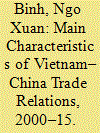

|
|
|
|
|
| Summary/Abstract |
Entering the 21st century, trade relations between Vietnam and China have grown strongly, making
positive contributions to the economic development of the two countries. However, the relationship in
the period 2000–15 also witnessed a number of thorny issues such as a serious trade imbalance against
Vietnam, the ‘North to South’ nature in the import and export structure of the two countries, Vietnam’s
growing dependence on bilateral trade with China, and so on. These issues have affected negatively
Vietnam’s economy. Based on data analysis, the author identifies the key characteristics of trade relations
between Vietnam and China and highlights possible solutions for Vietnam to move its trade relations
with China in a more balanced direction.
|
|
|
|
|
|
|
|
|
|
|
|
|
|
|
|
| 6 |
ID:
052419


|
|
|
|
|
| Publication |
Spring/Summer 2004.
|
|
|
|
|
|
|
|
|
|
|
|
|
|
|
|
| 7 |
ID:
134110
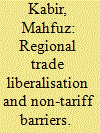

|
|
|
|
|
| Publication |
2014.
|
| Summary/Abstract |
Although trade liberalisation measures are in place for eight years, intraregional trade in South Asia has been meagre and is not encouraging at all as Bangladesh's export market in the region. India also granted duty free quota free access to almost all traded Bangladeshi products, which is also not showing significant increase in Bangladesh's export to reduce the country's mounting trade deficit with India. Therefore, overwhelming presence of non-tariff barriers has been perceived to be resulted in intra-regional trade significantly lower than expected. Given this context, the paper tries to identify the non-tariff barriers in South Asia in the context of Bangladesh's export expansion in this region. It takes a few product-specific cases in both export and import of Bangladesh to examine the barriers prevailing in neighbouring countries, viz. India, Nepal and Bhutan. The paper reveals that such barriers are related to bonded warehouse, gate pass, shipment and customs, infrastructure in land customs stations, visa, speed money, and excessive checking, which have been suggested to constrain expected gains from regional trade liberalisation measures. The paper argues that India's countervailing duty on garments import has not impacted negatively on Bangladesh's exports, but there is scope for further improvement if the duty is set equally for Indian and foreign manufacturers.
|
|
|
|
|
|
|
|
|
|
|
|
|
|
|
|
| 8 |
ID:
169956
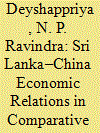

|
|
|
|
|
| Summary/Abstract |
The article examines recent trends in the economic relations between Sri Lanka and China focussing on trade, investment and tourism dimensions. Although bilateral economic ties between Sri Lanka and China have strengthened over time, the article demonstrates Sri Lanka’s low rank among China’s economic partners. For example, while China is the second-largest tourism partner of Sri Lanka in terms of tourist arrivals, Sri Lanka does not rank among even China’s top 25 tourist destinations.
Consequently, the article recommends certain policy priorities to ensure mutually beneficial economic relations. With regards to tourism, it recommends promoting Sri Lanka’s brand on Chinese e-tourism websites and social media, introducing user-friendly tourist apps in Chinese, strengthening air connectivity and celebrating Chinese festivals. Similarly, trade and investment could be facilitated by stronger links with Chinese cities and connecting Sri Lankan students in China to the Chinese industry via internships and building commercial networks from the ground up.
|
|
|
|
|
|
|
|
|
|
|
|
|
|
|
|
| 9 |
ID:
117803


|
|
|
|
|
| Publication |
2012.
|
| Summary/Abstract |
The twin-deficits theory has intrigued economists and policy-makers alike for the past few decades. In a Keynesian economy, budget deficit increases the absorption of the economy, causes import expansions, and thereby, worsens the trade deficit. It also causes domestic interest rates to rise, domestic currency to appreciate, and thereby, contributes to trade deficits. However, according to the Ricardian Equivalence Hypothesis (REH), rising budget deficits imply higher future tax liabilities so people would save more and consume less. As a result, an inter-temporal shift between taxes and budget deficits would have no impact on the real interest, or the trade deficit. Thus, the issue of whether the twin-deficits phenomenon holds becomes more of an empirical question, and the recent fiscal expansions to curb recession makes it timely to revisit the phenomenon, especially for the developing countries confronting both the deficits on a chronic basis. To this end, we make a case study of India, using the bounds- testing approach to cointegration and error-correction modelling on monthly and quarterly data over 1998-2009. Our results suggest that the twin-deficits theory holds for India in the short-run (validating the Keynesian channel) but not in the long-run (validating the REH).
|
|
|
|
|
|
|
|
|
|
|
|
|
|
|
|
| 10 |
ID:
182607


|
|
|
|
|
| Summary/Abstract |
India dropped out of the Regional Comprehensive Economic Partnership (RCEP)—which included the Association of Southeast Asian Nations (ASEAN) countries, China, South Korea, New Zealand, Japan and Australia—after negotiating for almost seven years in November 2018 on the grounds of national interest and also that free trade agreements (FTAs) did not amount to free trade and led to more trade diversion than trade creation. The cost and benefit of a regional agreement depend on the amount of trade creation with respect to trade diversion (Panagriya, 2000). This study tries to examine India’s concerns and, at the same time, highlights the cost of not joining RCEP. India’s trade deficit with 11 out of the 15 RCEP nations has been a major cause of concern. Unfavourable trade balance, concerns about the impact on dairy sector, economic slowdown, past experience with FTA’s, China factor, data localisation, rules of origin and the experience of ASEAN countries with Sino-FTA have been some of the reasons behind India’s decision to opt out of this mega multilateral agreement. Also, bilateral trade agreements with some RCEP countries such as Japan, Malaysia, Singapore, Thailand and South Korea were operational. A multilateral trade agreement with ASEAN countries was very much in place. So, trade between India and 12 of the RCEP member countries would not have changed much after India’s inclusion in the RCEP. The impact of lower tariffs would have been evident for the remaining three countries: China, Australia and New Zealand. Furthermore, there was fear of a massive surge in imports of manufactures from China and dairy imports from Australia and New Zealand. This study also examines the long-term impact of this decision and if India has missed out on becoming a part of the global value chain and gaining greater market access in the Asia-Pacific region. India’s policy of import substitution and protectionism did not capitulate desired results in the past. Hence, a critical evaluation of India’s decision and some validation on her concerns and fears have been done.
|
|
|
|
|
|
|
|
|
|
|
|
|
|
|
|
|
|
|
|
|